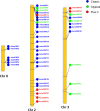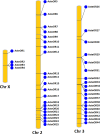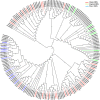Odorant Binding Proteins (OBPs) and Odorant Receptors (ORs) of Anopheles stephensi: Identification and comparative insights
- PMID: 35316281
- PMCID: PMC8939812
- DOI: 10.1371/journal.pone.0265896
Odorant Binding Proteins (OBPs) and Odorant Receptors (ORs) of Anopheles stephensi: Identification and comparative insights
Abstract
Anopheles stephensi is an important vector of malaria in the South Asia, the Middle East, and Eastern Africa. The olfactory system of An. stephensi plays an important role in host-seeking, oviposition, and feeding. Odorant binding proteins (OBPs) are globular proteins that play a pivotal role in insect olfaction by transporting semiochemicals through the sensillum lymph to odorant receptors (ORs). Custom motifs designed from annotated OBPs of Aedes aegypti, Drosophila melanogaster, and Anopheles gambiae were used for the identification of putative OBPs from protein sequences of the An. stephensi Indian strain. Further, BLASTp was also performed to identify missing OBPs and ORs. Subsequently, the presence of domains common to OBPs was confirmed. Identified OBPs were further classified into three sub-classes. Phylogenetic and syntenic analyses were carried out to find homology, and thus the evolutionary relationship between An. stephensi OBPs and ORs with those of An. gambiae, Ae. aegypti and D. melanogaster. Gene structure and physicochemical properties of the OBPs and ORs were also predicted. A total of 44 OBPs and 45 ORs were predicted from the protein sequences of An. stephensi. OBPs were further classified into the classic (27), atypical (10) and plus-C (7) OBP subclasses. The phylogeny revealed close relationship of An. stephensi OBPs and ORs with An. gambiae homologs whereas only five OBPs and two ORs of An. stephensi were related to Ae. aegypti OBPs and ORs, respectively. However, D. melanogaster OBPs and ORs were distantly rooted. Synteny analyses showed the presence of collinear block between the OBPs and ORs of An. stephensi and An. gambiae as well as Ae. aegypti's. No homology was found with D. melanogaster OBPs and ORs. As an important component of the olfactory system, correctly identifying a species' OBPs and ORs provide a valuable resource for downstream translational research that will ultimately aim to better control the malaria vector An. stephensi.
Conflict of interest statement
The authors have declared that no competing interests exist.
Figures











Similar articles
-
Genome-wide identification and characterization of odorant-binding protein (OBP) genes in the malaria vector Anopheles sinensis (Diptera: Culicidae).Insect Sci. 2016 Jun;23(3):366-76. doi: 10.1111/1744-7917.12333. Epub 2016 Apr 26. Insect Sci. 2016. PMID: 26970073
-
"Plus-C" odorant-binding protein genes in two Drosophila species and the malaria mosquito Anopheles gambiae.Gene. 2004 Feb 18;327(1):117-29. doi: 10.1016/j.gene.2003.11.007. Gene. 2004. PMID: 14960367
-
Identification and expression profiling of putative odorant-binding proteins in the malaria mosquitoes, Anopheles gambiae and A. arabiensis.Sci China C Life Sci. 2004 Dec;47(6):567-76. doi: 10.1360/03yc0232. Sci China C Life Sci. 2004. PMID: 15620114
-
Protein- and Peptide-Based Biosensors in Artificial Olfaction.Trends Biotechnol. 2018 Dec;36(12):1244-1258. doi: 10.1016/j.tibtech.2018.07.004. Epub 2018 Sep 10. Trends Biotechnol. 2018. PMID: 30213453 Free PMC article. Review.
-
A decade of invasive Anopheles stephensi sequence-based identification: toward a global standard.Trends Parasitol. 2024 Jun;40(6):477-486. doi: 10.1016/j.pt.2024.04.012. Epub 2024 May 16. Trends Parasitol. 2024. PMID: 38755024 Free PMC article. Review.
Cited by
-
Ligand-binding properties of XaffOBP9, a Minus-C odorant-binding protein from Xyleborus affinis (Coleoptera: Curculionidae: Scolytinae).Front Physiol. 2024 Jan 3;14:1326099. doi: 10.3389/fphys.2023.1326099. eCollection 2023. Front Physiol. 2024. PMID: 38235380 Free PMC article.
-
Nonlinear SAR Modelling of Mosquito Repellents for Skin Application.Toxics. 2023 Oct 2;11(10):837. doi: 10.3390/toxics11100837. Toxics. 2023. PMID: 37888688 Free PMC article.
-
Characterization of chemosensory genes in the subterranean pest Gryllotalpa Orientalis based on genome assembly and transcriptome comparison.BMC Genomics. 2025 Jan 14;26(1):33. doi: 10.1186/s12864-025-11217-5. BMC Genomics. 2025. PMID: 39810101 Free PMC article.
References
-
- Rickman LS, Jones TR, Long GW, Paparello S, Schneider I, Paul CF, et al.. Plasmodium falciparum-infected Anopheles stephensi inconsistently transmit malaria to humans. NAVAL MEDICAL RESEARCH INST BETHESDA MD; 1990. - PubMed
-
- Djadid ND, Gholizadeh S, Aghajari M, Zehi AH, Raeisi A, Zakeri SJAt. Genetic analysis of rDNA-ITS2 and RAPD loci in field populations of the malaria vector, Anopheles stephensi (Diptera: Culicidae): implications for the control program in Iran. 2006;97(1):65–74. doi: 10.1016/j.actatropica.2005.08.003 - DOI - PubMed
MeSH terms
Substances
LinkOut - more resources
Full Text Sources
Medical
Research Materials

